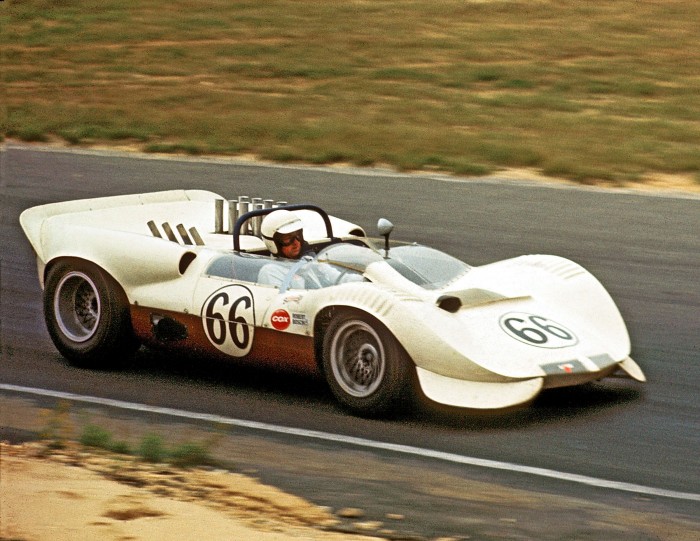On the 50th anniversary of its soggy victory, the Chaparral 2 returns to Sebring
Posted on Nov 26, 2014 in Featured | 2 comments

The Chaparral 2 in action.
Given the focus that Ford had put into beating Ferrari in endurance racing, motorsport fans probably expected the Ford GT40 to repeat its 1965 Daytona victory with a win at Sebring. Instead, it was an innovative team from Texas, running an open-cockpit, Chevy-powered sports racer of their own design, that claimed victory in the 1965 race. In honor of the 50th anniversary of this win, the Chaparral 2 will once again take to the runways of Sebring in 2015, driven in exhibition laps by Jim Hall II, the son of its creator.
Tired of buying what they perceived to be second-tier race cars from Europe, Texans Jim Hall and Hap Sharp figured they could build a better car on their own. The pair had already teamed up with other racers in the Midland, Texas, area to build Rattlesnake Raceway, and thanks to money made in the oil business, funding such a project, or funding the development of an all-new race car, wasn’t much of an issue. Needing a place to start, the pair bought a modified version of the Scarab sports racer from builders Dick Troutman and Tom Barnes. In total, four more of these “Chaparral 1” models were built, but none achieved the same winning record as the original Scarab.
The Chaparral 1 did provide Hall with a rolling laboratory in which to test his theories of race car development, and in late 1963 Hall debuted an all-new Chaparral model, designed and built in Midland, Texas. Calling the car innovative would be an understatement; instead of a conventional tube frame, the Chaparral 2 used a steel-reinforced fiberglass monocoque. To lower the front of the car and improve weight distribution, the Chevrolet V-8 engine was moved amidships, positioned behind the driver. Suspension design was borrowed from Lotus, while class-leading suppliers of the day provided other needed mechanical bits. The assemblage of parts worked, and at the car’s first outing, the 1963 Los Angeles Times Grand Prix at Riverside, Hall put the Chaparral 2 on the pole and led the race until an electrical fire ended his day early.
The rest of the season was spent sorting the usual development problems, but Hall’s access to GM ‘s aerodynamic research would prove invaluable. When front lift became an issue, GM engineers provided assistance to Hall in reshaping the Chaparral 2’s front end, pointing and lowering the nose and adding a pair of chin spoilers at the bottom of each front fender. In 1964, the Chaparral 2 delivered its first victory, at a USRRC race in Pensacola, Florida, but Hall kept on improving the car.
At Laguna Seca he introduced an experimental automatic gearbox designed by GM, which allowed a driver to work two pedals instead of the usual three. In later Chaparral versions, the automatic gearbox would also allow a driver to change the angle of attack on the car’s wing with his left foot, adding downforce for corners or decreasing drag for more speed on straights.
Hall’s drive for innovation didn’t end with chassis development, either. At Sebring in 1965, he brought in a meteorologist to provide a detailed forecast; rain was expected, but knowing exactly when that rain would hit could pay big dividends. Armed with this information, Hall had built a seven-lap lead by the time rain began to fall in earnest. At one point during the 12-hour race, the team was forced to park the car, as visibility had fallen from “bad” to “nonexistent,” and, as son Jim Hall II relates, both Hall and co-driver Sharp were glad to even finish the race. Though both drivers spent stints sitting in pools of water in the open-cockpit racer, the end result proved worth the suffering, with the Chaparral 2 delivering a four-lap victory over its nearest rival, a Ford GT40 driven by Ken Miles and Bruce McLaren.
Jim Hall II will pilot the Chaparral II for exhibition laps during this year’s 12 Hours of Sebring, the 63rd running of the storied event. Hall II has a racing resume of his own, and operates the Jim Hall Kart Racing School in Oxnard, California, as his day job. He’s driven the Chaparral 2 before as well, sharing driving duties with Lord March and Gil de Ferran at the Goodwood Festival of Speed and showing off for fans at Laguna Seca during the Monterey Historics. Hall II will pilot the Chaparral 2 on Friday, March 20, ahead of the Continental Tire SportsCar Challenge race, and again on Saturday, March 21, prior to the start of the TUDOR United SportsCar Championship race.





When I was a kid in the ’60’s I used read about the exploits of the Chaparral and Jim Hall. I was a Chevy guy then and now and back in the ’60’s with GM having pulled out of racing there weren’t many Chevy powered cars to cheer for.
The Chaparral and Jim Hall took care of that.
A super car from my teenage years . Don’t those exhaust stacks look great ? Oh , that modern race cars looked this good .